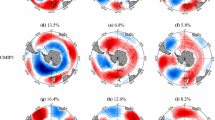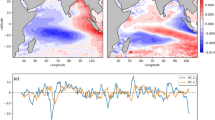Abstract
Empirical orthogonal function (EOF) analysis reveals a co-variability of Sea surface temperatures (SSTs) in the Southern Hemisphere (0°–60°S). In the South Indian and Atlantic Oceans, there is a subtropical dipole pattern slanted in the southwest-northeast direction. In the South Pacific Ocean, a meridional tripole structure emerges, whose middle pole co-varies with the dipoles in the South Indian and Atlantic Oceans and is used in this study to track subtropical Pacific variability. The South Indian and Atlantic Ocean dipoles and the subtropical Pacific variability are phase-locked in austral summer. On the inter-decadal time scales, the dipoles in the South Indian and Atlantic Oceans weaken in amplitude after 1979/1980. No such weakening is found in the subtropical South Pacific Ocean. Interestingly, despite the reduced amplitude, the correlation of the Indian Ocean and Atlantic dipoles with El Niño and Southern Oscillation (ENSO) are enhanced after 1979/1980. The same increase in correlation is found for subtropical South Pacific variability after 1979/1980. These inter-decadal modulations imply that the Southern Hemisphere participates in part of the climate shift in the late 1970s. The correlation between Southern Hemisphere SST and ENSO reduces after 2000.
Similar content being viewed by others
References
Behera, S. K., and Yamagata, T., 2001. Subtropical SST dipole events in the southern Indian Ocean. Geophysical Research Letters, 28: 327–330, DOI: 10.1029/2000GL011451.
De Almeida, R. A. F., Nobre, P., Haarsma, R. J., and Campos, E. J. D., 2007. Negative ocean-atmosphere feedback in the South Atlantic Convergence Zone. Geophysical Research Letters, 34, L18809, DOI: 10.1029/2007GL030401.
Deser, C., Alexander, M. A., Xie, S.-P., and Phillips, A. S., 2010. Sea surface temperature variability: Patterns and mechanisms. Annual Review of Materials Research, 2: 115–43.
Fauchereau, N., Trzaska, S., Richard, Y., Roucou, P., and Camberlin, P., 2003. SST co-variability in the southern Atlantic and Indian Oceans and its connections with the atmospheric circulation in the Southern Hemisphere. International Journal of Climatology, 23: 663–677.
Hermes, J. C., and Reason, C. J. C., 2005. Ocean model diagnosis of interannual coevolving SST variability in the South Indian and South Atlantic Oceans. Journal of Climate, 18: 2864–2882.
Huang, B., and Shukla, J., 2006. Interannual SST variability in the southern subtropical and extra-tropical ocean. Technical Report 223. Center for Ocean-Land-Atmosphere Studies (COLA), Calverton, Maryland, 20pp.
Kalnay, E., Kanamitsu, M., Kistler, R., Collins, W., Deaven, D., Gandin, L., Iredell, M., Saha, S., White, G., Woollen, J., Zhu, Y., Leetmaa, A., Reynolds, R., Chelliah, M., Ebisuzaki, W., Higgins, W., Janowiak, J., Mo, K. C., Ropelewski, C., Wang, J., Jenne, R., and Joseph, D., 1996. The NCEP/NCAR 40-year reanalysis project. Bulletin of the American Meteorological Society, 77: 437–470.
Kistler, R., Collins, W., Saha, S., White, G., Woollen, J., Kalnay, E., Chelliah, M., Ebisuzaki, W., Kanamitsu, M., Kousky, V., van den Dool, H., Jenne, R., and Fiorino, M., 2001. The NCEP-NCAR 50-year reanalysis: Monthly means CD-ROM and documentation. Bulletin of the American Meteorological Society, 82: 247–267.
Mantua, N., Hare, S. J., Zhang, Y., Wallace, J. M., and Francis, R. C., 1997. A Pacific interdecadal oscillation with impacts on salmon production. Bulletin of the American Meteorological Society, 78: 1069–1079.
Nnamchi, H. C., Li, J., and Anyadike, R. N. C., 2011. Does a dipole mode really exist in the South Atlantic Ocean? Journal of Geophysical Research, 116, D15104, DOI: 10.1029/2010JD015579.
Reason, C. J. C., 2001. Subtropical Indian Ocean SST dipole events and southern African rainfall. Geophysical Research Letters, 28: 2225–2227, DOI: 10.1029/2000GL012735.
Smith, T. M., Reynolds, R. W., Peterson, T. C., and Lawrimore, J., 2008. Improvements to NOAA’s historical merged landocean surface temperature analysis (1880–2006). Journal of Climate, 21: 2283–2296.
Sterl, A., and Hazeleger, W., 2003. Coupled variability and airsea interaction in the South Atlantic Ocean. Climate Dynamics, 21: 559–571.
Suzuki, R., Behera, S. K., Iizuka, S., and Yamagata, T., 2004. Indian Ocean subtropical dipole simulated using a coupled general circulation model. Journal of Geophysical Research, 109, C09001, DOI: 10.1029/2003JC001974.
Terray, P., 2011. Southern Hemisphere extra-tropical forcing: a new paradigm for El Niño-Southern Oscillation. Climate Dynamics, 36: 2171–2199.
Terray, P., and Dominiak S., 2005. Indian Ocean sea surface temperature and El Niño-Southern Oscillation: a new perspective. Journal of Climate, 18: 1351–1368.
Venegas, S. A., Mysak, L. A., and Straub, D. N., 1997. Atmosphere-ocean coupled variability in the South Atlantic. Journal of Climate, 10: 2904–2920.
Wang, B., 1995. Interdecadal changes in El Niño onset in the last four decades. Journal of Climate, 8: 267–285.
Wang, F., 2010a. Subtropical dipole mode in the Southern Hemisphere: A global view. Geophysical Research Letters, 37, L10702, DOI: 10.1029/2010GL042750.
Wang, F., 2010b. Thermodynamical coupled modes in the tropical atmosphere-ocean: An analytical solution. Journal of the Atmospheric Sciences, 67: 1667–1677, DOI: 10.1175/2009 JAS3262.1.
Woodruff, S. D., Worley, S. J., Lubker, S. J., Ji, Z., Freeman, J. E., Berry, D. I., Brohan, P., Kent, E. C., Reynolds, R. W., Smith, S. R., and Wilkinson, C., 2011. ICOADS release 2.5: Extensions and enhancements to the surface marine meteorological archive. International Journal of Climatology, 31: 951–967.
Xie, S. P., Kubokawa, A., and Hanawa, K., 1993a. Evaporation-wind feedback and the organizing of tropical convection on the planetary scale. Part I: Quasi-linear instability. Journal of the Atmospheric Sciences, 50: 3873–3883.
Xie, S. P., Kubokawa, A., and Hanawa, K., 1993b. Evaporation-wind feedback and the organizing of tropical convection on the planetary scale. Part II: Nonlinear evolution. Journal of the Atmospheric Sciences, 50: 3884–3893.
Xue, Y., Smith, T. M., and Reynolds, R. W., 2003. Interdecadal changes of 30-yr SST normals during 1871–2000. Journal of Climate, 16: 1601–1612.
Yeh, S. W., Kug, J. S., Dewitte, B., Kwon, M. H, Kirtman, B. P., and Jin, F. F., 2009. El Niño in a changing climate. Nature, 461: 511–514.
Author information
Authors and Affiliations
Corresponding author
Rights and permissions
About this article
Cite this article
Yan, L., Du, Y. & Zhang, L. Southern ocean SST variability and its relationship with ENSO on inter-decadal time scales. J. Ocean Univ. China 12, 287–294 (2013). https://doi.org/10.1007/s11802-013-2262-1
Received:
Revised:
Accepted:
Published:
Issue Date:
DOI: https://doi.org/10.1007/s11802-013-2262-1




